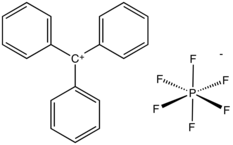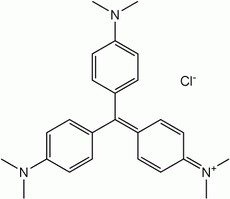Triphenylmethyl hexafluorophosphate
 | |
| Names | |
|---|---|
| Other names
Trityl hexafluorophosphate Triphenylcarbenium hexafluorophosphate | |
| Identifiers | |
| ECHA InfoCard | 100.006.467 |
| Properties | |
| C19H15F6P | |
| Molar mass | 388.31 g/mol |
| Appearance | brown powder |
| Melting point | 145 °C (293 °F; 418 K) |
| Hazards | |
| Safety data sheet | |
| R-phrases (outdated) | R34, R26, R36/37, R39, R45 |
Except where otherwise noted, data are given for materials in their standard state (at 25 °C [77 °F], 100 kPa). | |
| Infobox references | |
Triphenylmethyl hexafluorophosphate is an organic salt with the formula (C6H5)3CPF6. It is a brown powder that hydrolyzes readily to triphenylmethanol. Triphenylmethyl hexafluorophosphate is used as a catalyst and reagent in organic syntheses.[1]
Preparation
Triphenylmethyl hexafluorophosphate can be prepared by combining silver hexafluorophosphate with triphenylmethyl chloride:[2]
- AgPF6 + (C6H5)3CCl → (C6H5)3CPF6 + AgCl
A second method involves protonolysis of generating triphenylmethanol :[3]
- HPF6 + (C6H5)3COH → (C6H5)3CPF6 + H2O
Structure and reactions
Triphenylmethyl hexafluorophosphate readily hydrolyzes, in a reaction that is the reverse of one of its syntheses:[4]
- (C6H5)3CPF6 + H2O → (C6H5)3COH + HPF6
Triphenylmethyl hexafluorophosphate has been used for abstracting hydride. Treatment of metal-alkene and diene complexes one can generate allyl and pentadienyl complexes, respectively.[1]
Triphenylmethyl perchlorate is a common substitute for triphenylmethyl hexafluorophosphate. However, the perchlorate is not used as widely, because, like other organic perchlorates, it is potentially explosive.[1]
Triarylmethane dyes
Triarylmethane dyes are derivatives are stabilized version of the trityl cation, so much so that they are water-soluble and are often obtained as the chloride salts. These dyes have strong electron donor groups, often amines, at the p-positions of two or three of the aryl groups.[5]
- Triarylmethane dyes

 New fuchsine dye.
New fuchsine dye.
See also
References
- 1 2 3 Urch, C. (2001). "Triphenylmethyl Hexafluorophosphate". Encyclopedia of Reagents for Organic Synthesis. doi:10.1002/047084289X.rt363f. ISBN 0471936235.
- ↑ Sharp, D., Shepard, N. (1956). "Complex Fluorides. Part VIII". University Chemical Laboratory, Cambridge: 674–682.
- ↑ Olah, G., Svoboda, J., Olah, J. (1972). "Preparative Carbocation Chemistry; IV. Improved Preparation of Triphenylcarbenium (Trityl) Salts". Synthesis. 1972 (10): 544. doi:10.1055/s-1972-21914.
- ↑ Fernandez-Galan, R.; Manzano, B; Otero, A; Lanfranchi, M; Pellinghelli, M. (1994). "19F and 31P NMR Evidence for Silver Hexafluorophosphate Hydrolysis in Solution". Inorg. Chem. 33 (10): 2309–2312. doi:10.1021/ic00088a039.
- ↑ Thomas Gessner and Udo Mayer "Triarylmethane and Diarylmethane Dyes" in Ullmann's Encyclopedia of Industrial Chemistry 2002, Wiley-VCH, Weinheim.doi:10.1002/14356007.a27_179